The Cambridge History of China. Vol. 06. Alien Regimes and Border States, 907-1368
Подождите немного. Документ загружается.

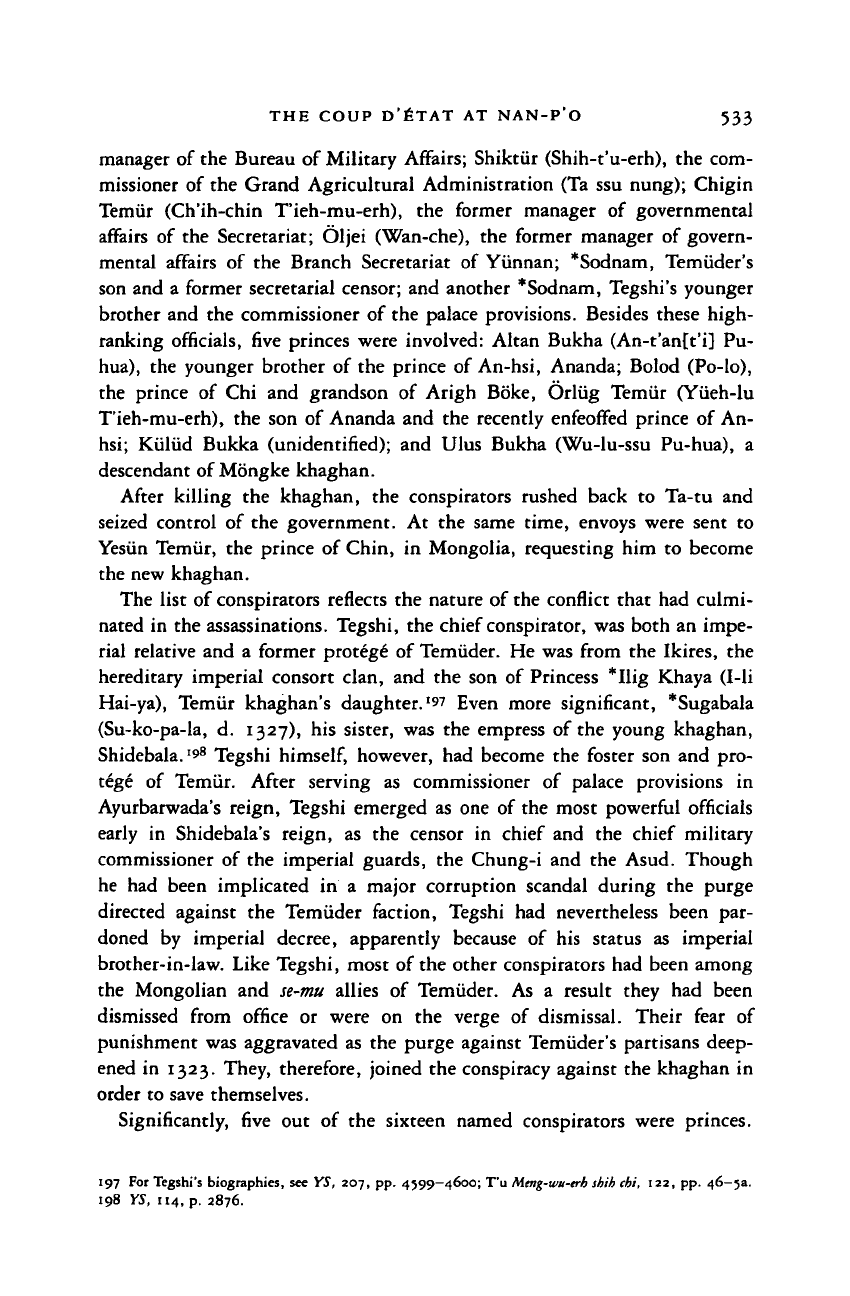
THE COUP D'ETAT AT NAN-P'O 533
manager of the Bureau of Military Affairs; Shiktiir (Shih-t'u-erh), the com-
missioner of the Grand Agricultural Administration (Ta ssu nung); Chigin
Temiir (Ch'ih-chin T'ieh-mu-erh), the former manager of governmental
affairs of the Secretariat; Oljei (Wan-che), the former manager of govern-
mental affairs of the Branch Secretariat of Yunnan; *Sodnam, Temiider's
son and a former secretarial censor; and another *Sodnam, Tegshi's younger
brother and the commissioner of the palace provisions. Besides these high-
ranking officials, five princes were involved: Altan Bukha (An-t'an[t'i] Pu-
hua),
the younger brother of the prince of An-hsi, Ananda; Bolod (Po-lo),
the prince of Chi and grandson of Arigh Boke, Orliig Temiir (Yiieh-lu
T'ieh-mu-erh), the son of Ananda and the recently enfeoffed prince of An-
hsi;
Kiiliid Bukka (unidentified); and Ulus Bukha (Wu-lu-ssu Pu-hua), a
descendant of Mongke khaghan.
After killing the khaghan, the conspirators rushed back to Ta-tu and
seized control of the government. At the same time, envoys were sent to
Yesiin Temiir, the prince of Chin, in Mongolia, requesting him to become
the new khaghan.
The list of conspirators reflects the nature of the conflict that had culmi-
nated in the assassinations. Tegshi, the chief conspirator, was both an impe-
rial relative and a former protege
1
of Temiider. He was from the Ikires, the
hereditary imperial consort clan, and the son of Princess *Ilig Khaya (I-li
Hai-ya),
Temiir khaghan's daughter.'
97
Even more significant, *Sugabala
(Su-ko-pa-la, d. 1327), his sister, was the empress of the young khaghan,
Shidebala.'9
8
Tegshi
himself,
however, had become the foster son and pro-
tege of Temiir. After serving as commissioner of palace provisions in
Ayurbarwada's reign, Tegshi emerged as one of the most powerful officials
early in Shidebala's reign, as the censor in chief and the chief military
commissioner of the imperial guards, the Chung-i and the Asud. Though
he had been implicated in a major corruption scandal during the purge
directed against the Temiider faction, Tegshi had nevertheless been par-
doned by imperial decree, apparently because of his status as imperial
brother-in-law. Like Tegshi, most of the other conspirators had been among
the Mongolian and se-mu allies of Temiider. As a result they had been
dismissed from office or were on the verge of dismissal. Their fear of
punishment was aggravated as the purge against Temiider's partisans deep-
ened in 1323. They, therefore, joined the conspiracy against the khaghan in
order to save themselves.
Significantly, five out of the sixteen named conspirators were princes.
197 For Tegshi's biographies, see YS, 207, pp. 4599—4600; T'u Mmg-wu-erb shih cbi, 122, pp. 46-53.
198 YS, 114, p. 2876.
Cambridge Histories Online © Cambridge University Press, 2008
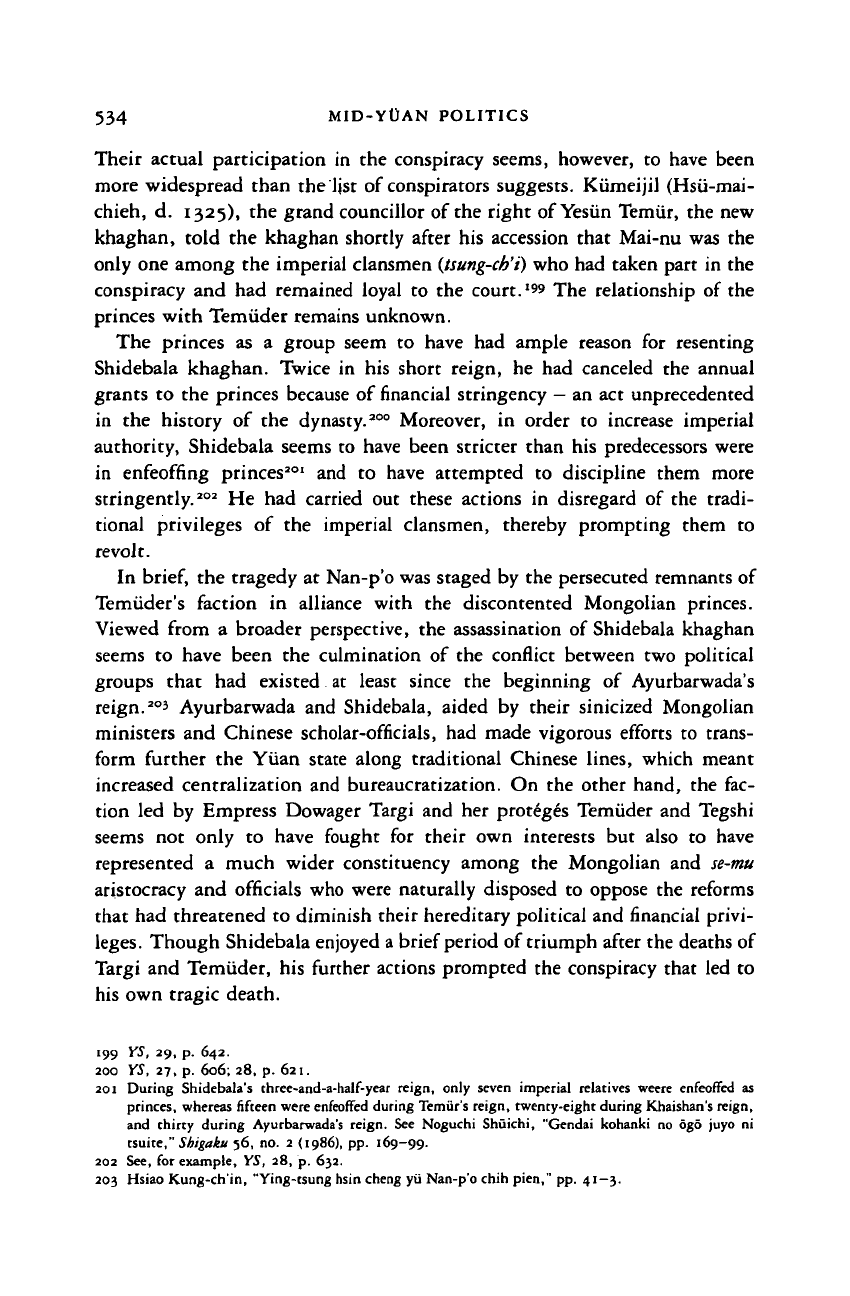
534 MID-YOAN POLITICS
Their actual participation in the conspiracy seems, however, to have been
more widespread than the list of conspirators suggests. Kiimeijil (Hsii-mai-
chieh, d. 1325), the grand councillor of the right of Yesiin Temiir, the new
khaghan, told the khaghan shortly after his accession that Mai-nu was the
only one among the imperial clansmen
(tsung-ch'i)
who had taken part in the
conspiracy and had remained loyal to the court.
1
" The relationship of the
princes with Temiider remains unknown.
The princes as a group seem to have had ample reason for resenting
Shidebala khaghan. Twice in his short reign, he had canceled the annual
grants to the princes because of financial stringency
—
an act unprecedented
in the history of the dynasty.
200
Moreover, in order to increase imperial
authority, Shidebala seems to have been stricter than his predecessors were
in enfeoffing princes
201
and to have attempted to discipline them more
stringently.
202
He had carried out these actions in disregard of the tradi-
tional privileges of the imperial clansmen, thereby prompting them to
revolt.
In
brief,
the tragedy at Nan-p'o was staged by the persecuted remnants of
Temiider's faction in alliance with the discontented Mongolian princes.
Viewed from a broader perspective, the assassination of Shidebala khaghan
seems to have been the culmination of the conflict between two political
groups that had existed at least since the beginning of Ayurbarwada's
reign.
203
Ayurbarwada and Shidebala, aided by their sinicized Mongolian
ministers and Chinese scholar-officials, had made vigorous efforts to trans-
form further the Yuan state along traditional Chinese lines, which meant
increased centralization and bureaucratization. On the other hand, the fac-
tion led by Empress Dowager Targi and her proteges Temiider and Tegshi
seems not only to have fought for their own interests but also to have
represented a much wider constituency among the Mongolian and
se-mu
aristocracy and officials who were naturally disposed to oppose the reforms
that had threatened to diminish their hereditary political and
financial
privi-
leges.
Though Shidebala enjoyed a brief period of triumph after the deaths of
Targi and Temiider, his further actions prompted the conspiracy that led to
his own tragic death.
199 YS, 29, p. 642.
200 YS, 27, p. 606; 28, p. 621.
201 During Shidebala's three-and-a-half-year reign, only seven imperial relatives weere enfeoffed as
princes, whereas fifteen were enfeoffed during Temur's reign, twenty-eight during Khaishan's reign,
and thirty during Ayurbarwada's reign. See Noguchi Shuichi, "Gendai kohanki no ogo juyo ni
tsuite," Shigaku 56, no. 2 (1986), pp. 169-99.
202 See, for example, YS, 28, p. 632.
203 Hsiao Kung-ch'in, "Ying-tsung hsin cheng yii Nan-p'o chih pien," pp. 41—3.
Cambridge Histories Online © Cambridge University Press, 2008
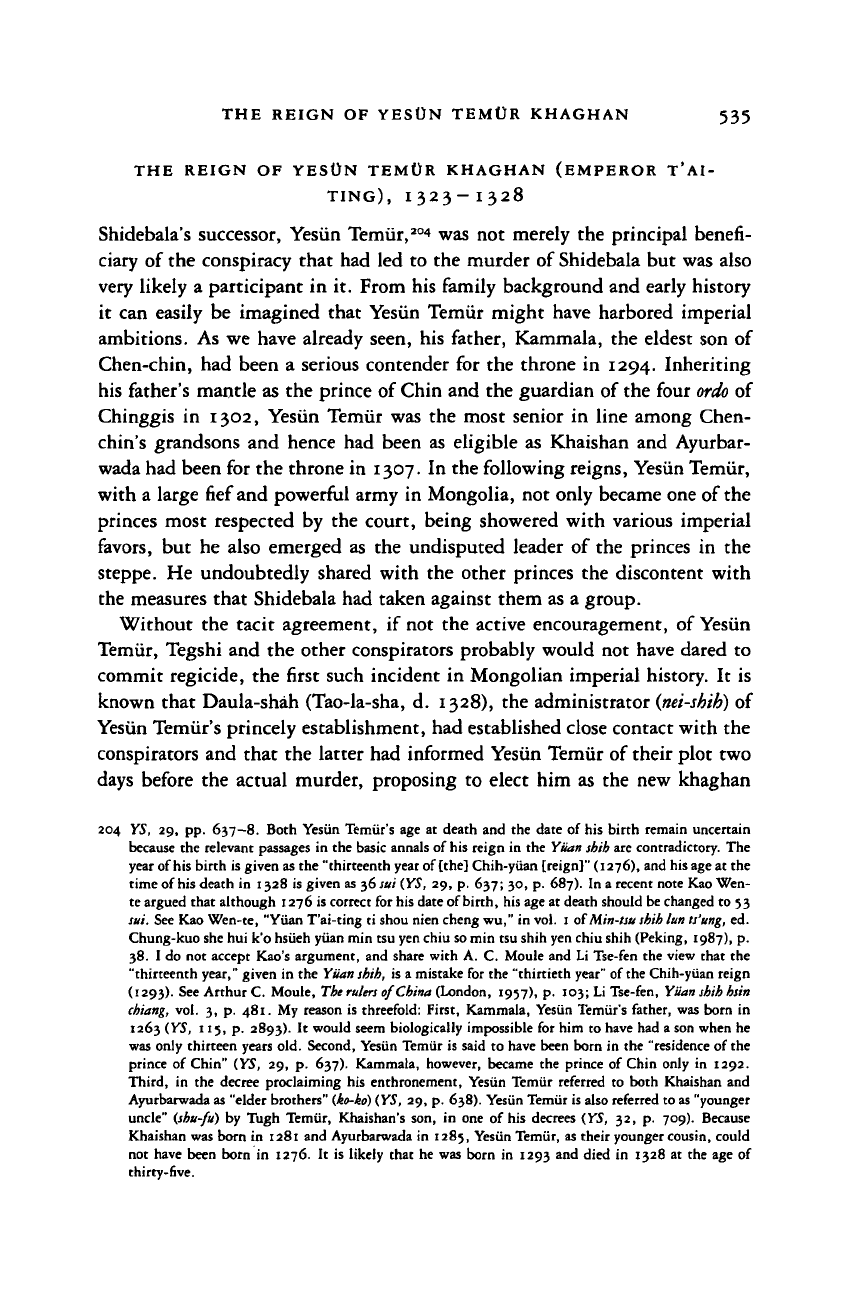
THE REIGN OF YESON TEMOR KHAGHAN 535
THE REIGN OF YESON TEMOR KHAGHAN (EMPEROR T*AI-
TING), 1323- 1328
Shidebala's successor, Yesiin Temur,
2
°
4
was not merely the principal benefi-
ciary of the conspiracy that had led to the murder of Shidebala but was also
very likely a participant in it. From his family background and early history
it can easily be imagined that Yesiin Temiir might have harbored imperial
ambitions. As we have already seen, his father, Kammala, the eldest son of
Chen-chin, had been a serious contender for the throne in 1294. Inheriting
his father's mantle as the prince of Chin and the guardian of the four
ordo
of
Chinggis in 1302, Yesiin Temiir was the most senior in line among Chen-
chin's grandsons and hence had been as eligible as Khaishan and Ayurbar-
wada had been for the throne in 1307. In the following reigns, Yesiin Temiir,
with a large fief and powerful army in Mongolia, not only became one of the
princes most respected by the court, being showered with various imperial
favors, but he also emerged as the undisputed leader of the princes in the
steppe. He undoubtedly shared with the other princes the discontent with
the measures that Shidebala had taken against them as a group.
Without the tacit agreement, if not the active encouragement, of Yesiin
Temiir, Tegshi and the other conspirators probably would not have dared to
commit regicide, the first such incident in Mongolian imperial history. It is
known that Daula-shah (Tao-la-sha, d. 1328), the administrator
{nei-shib)
of
Yesiin Temiir's princely establishment, had established close contact with the
conspirators and that the latter had informed Yesiin Temiir of their plot two
days before the actual murder, proposing to elect him as the new khaghan
204 YS, 29, pp. 637—8. Both Yesiin Temiir's age at death and the date of his bitth remain uncertain
because the relevant passages in the basic annals of his reign in the Yiian shih are contradictory. The
year of his birth is given as the "thirteenth year of
[the]
Chih-yuan
[reign]"
(1276), and his age at the
time of his death in 1328 is given as 36™/ (YS, 29, p. 637; 30, p. 687). In a recent note Kao Wen-
te argued that although 1276 is correct for his date of birth, his age at death should be changed to 33
sui. See Kao Wen-te, "Yiian T'ai-ting ti shou nien cheng wu," in vol. 1 of Min-tsu shih lun
Is'ung,
ed.
Chung-kuo she hui k'o hsiieh yiian min tsu yen chiu so min tsu shih yen chiu shih (Peking, 1987), p.
38.
I do not accept Kao's argument, and share with A. C. Moule and Li Tse-fen the view that the
"thirteenth year," given in the Yuan shih, is a mistake for the "thirtieth year" of the Chih-yuan reign
(1293).
See Arthur C. Moule, The
rulers
of China (London, 1957), p. 103; Li Tse-fen, Yiian shih hsin
chiang, vol. 3, p. 481. My reason is threefold: First, Kammala, Yesun Temiir's father, was born in
1263 (YS, 115, p. 2893). It would seem biologically impossible for him to have had a son when he
was only thirteen years old. Second, Yesiin Temiir is said to have been born in the "residence of the
prince of Chin" (YS, 29, p. 637). Kammala, however, became the prince of Chin only in 1292.
Third, in the decree proclaiming his enthronement, Yesun Temiir referred to both Khaishan and
Ayurbarwada as "elder brothers"
(ko-ko)
(YS, 29, p. 638). Yesiin Temiir is also referred to as "younger
uncle" (shu-fu) by Tugh Temiir, Khaishan's son, in one of his decrees (YS, 32, p. 709). Because
Khaishan was born in 1281 and Ayurbarwada in 128;, Yesiin Temur, as their younger cousin, could
not have been born in 1276. It is likely that he was born in 1293 and died in 1328 at the age of
thirty-five.
Cambridge Histories Online © Cambridge University Press, 2008

536 MID-YOAN POLITICS
should the planned assassination be successful. The basic annals of Yesiin
Temiir's reign in the Yuan sbih state that Yesiin Temiir did try to warn
Shidebala khaghan about the plot as soon as he had learned about it but that
the assassination had taken place before his messenger reached Shang-tu. This
version of the story, however, is probably a whitewash concocted by Yesiin
Temiir's partisans after his enthronement.
20
' Tugh Temiir (r. 1328 and
I
3
2
9~3
2
)»
w
ho seized the throne from Yesiin Temiir's son in 1328, later
alleged that Yesiin Temiir had actually colluded with Tegshi in the murder,
and his accusation was perhaps not unfounded.
206
The
purge
Whatever his relationship with the conspirators, as soon as he had received
the imperial seal sent by the conspirators, Yesiin Temiir enthroned himself on
the bank of the Keriilen River in Mongolia on 4 October, exactly one month
after Shidebala's murder. Even though his accession was the result of a bloody
coup d'etat, in the edict issued to proclaim his enthronement Yesiin Temiir
defended his legitimacy as the new khaghan on the basis of his seniority
among the grandsons of Chen-chin and also the consensus reached among the
princes and ministers in Mongolia and China.
207
Perhaps in accordance with his original agreement with the conspirators,
on the day of his accession Esen Temiir was made the grand councillor of the
right, and Tegshi, the manager of the Bureau of Military Affairs. This
agreement, however, was not to be honored for long, for one month later,
once his party had established initial control over the two capitals, the new
khaghan launched a bloody purge against his erstwhile allies, simultaneously
in Ta-tu and Shang-tu. Esen Temiir, Tegshi, and other bureaucratic partici-
pants in the coup d'etat were executed, and the five princes who had been
directly involved were exiled to distant places.
208
The purge of the conspira-
tors was Yesiin Temiir's masterstroke to boost his legitimacy. That is, he had
205 YS, 29, pp. 637-8; 136, p. 3305; 207, p. 4600.
206 YS, 32, p. 709.
207 YS, 29, pp. 638—9. Of all the
edicts proclaiming
the enthronement of
Yuan
khaghans,
T'ai-ting's
is
the
only
one written in the
vernacular Chinese language
of the
time
and
clearly reflects that
it was
translated from
a Mongolian original.
This shows that there were
no
Chinese literati accompanying
Yesiin Temiir
at the
time
of his enthronement. The
text
in
classical Chinese
now
found
in the Ch'ien-
lung editions
of the
Yuan shib
is a
later
rendition. See
Chang
Yiian-chi,
Chiao sbih
sui pi (Taipei,
'967), pp. H2a-i3b.
208 YS, 29, pp. 639—41.
Yesiin Temiir
may
have reached
a
secret
agreement
with
the
officials
in
Ta-tu
who
remained loyal
to the
late
Shidebala khaghan.
Under
the leadership of
Chang
Kuei,
this group
of
officials sent
a
letter
to
Yesiin Temiir urging
him to
accept
the
throne
and to eliminate the conspira-
tors. See
Chang Kuei's
epitaph by Yii Chi in Su
T'ien-chiieh,
Kuoch'aoum Ui, 52, pp. 17b-18a. The
relevant passage is
missing
in Yii Chi,
Too yuan bsiitb
ku lu, 18, p. 12a; see
also
pp.
12b—13a
for the
early reactions
of the
officials
in
Ta-tu
to the murders.
Cambridge Histories Online © Cambridge University Press, 2008
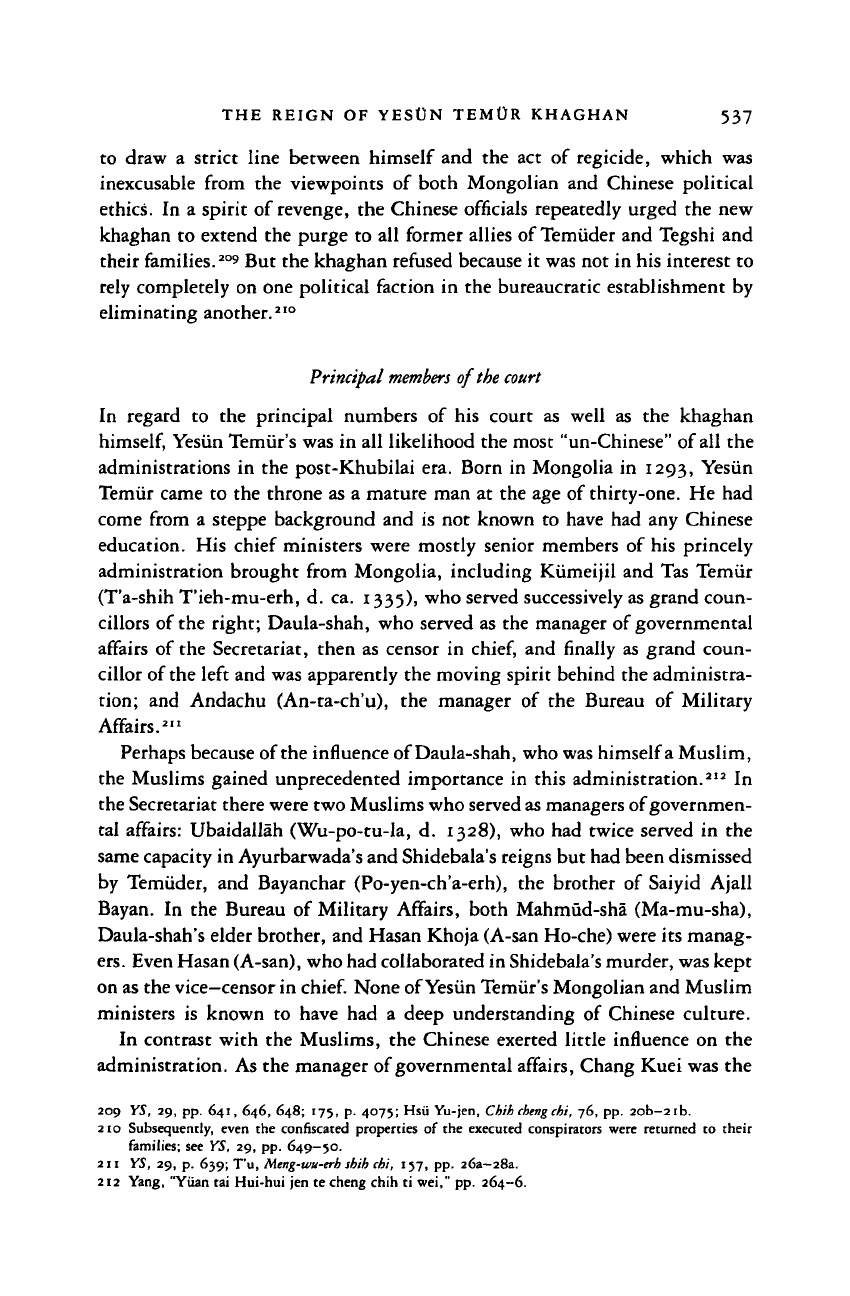
THE REIGN
OF
YESON TEMOR KHAGHAN
537
to draw
a
strict line between himself
and the act of
regicide, which
was
inexcusable from
the
viewpoints
of
both Mongolian
and
Chinese political
ethics.
In a
spirit
of
revenge,
the
Chinese officials repeatedly urged
the new
khaghan
to
extend
the
purge
to all
former allies
of
Temiider
and
Tegshi
and
their families.
209
But the
khaghan refused because
it was not in his
interest
to
rely completely
on one
political faction
in the
bureaucratic establishment
by
eliminating another.
210
Principal members of the court
In regard
to the
principal numbers
of his
court
as
well
as the
khaghan
himself,
Yesiin Temiir's
was in all
likelihood
the
most "un-Chinese"
of
all
the
administrations
in the
post-Khubilai
era.
Born
in
Mongolia
in 1293,
Yesiin
Temiir came
to the
throne
as a
mature
man at the age of
thirty-one.
He had
come from
a
steppe background
and is not
known
to
have
had any
Chinese
education.
His
chief ministers were mostly senior members
of his
princely
administration brought from Mongolia, including Kiimeijil
and Tas
Temiir
(T'a-shih T'ieh-mu-erh,
d. ca.
1335),
who
served successively
as
grand coun-
cillors
of the
right; Daula-shah,
who
served
as the
manager
of
governmental
affairs
of the
Secretariat, then
as
censor
in chief, and
finally
as
grand coun-
cillor
of
the left
and was
apparently
the
moving spirit behind
the
administra-
tion;
and
Andachu (An-ta-ch'u),
the
manager
of the
Bureau
of
Military
Affairs.
2
'
1
Perhaps because
of
the influence
of
Daula-shah,
who
was himself a Muslim,
the Muslims gained unprecedented importance
in
this administration.
212
In
the Secretariat there were
two
Muslims
who
served as managers of governmen-
tal affairs: Ubaidallah (Wu-po-tu-la,
d.
1328),
who had
twice served
in the
same capacity
in
Ayurbarwada's
and
Shidebala's reigns
but had
been dismissed
by Temiider,
and
Bayanchar (Po-yen-ch'a-erh),
the
brother
of
Saiyid Ajall
Bayan.
In the
Bureau
of
Military Affairs, both Mahmiid-sha (Ma-mu-sha),
Daula-shah's elder brother,
and
Hasan Khoja (A-san Ho-che) were
its
manag-
ers.
Even Hasan (A-san), who
had
collaborated
in
Shidebala's murder, was kept
on
as the
vice-censor
in chief.
None of Yesiin Temiir's Mongolian
and
Muslim
ministers
is
known
to
have
had a
deep understanding
of
Chinese culture.
In contrast with
the
Muslims,
the
Chinese exerted little influence
on the
administration.
As the
manager
of
governmental affairs, Chang Kuei
was the
209
YS, 29, pp. 641, 646, 648; 175, p.
4075; Hsii Yu-jen, Cbih chengcbi,
76, pp.
2ob-2ib.
210 Subsequently, even
the
confiscated properties
of the
executed conspirators were returned
to
their
families;
see YS, 29, pp.
649-50.
211
YS, 29, p. 639; T'u,
Matg-wu-erb shih
cbi, 157, pp.
26a—28a.
212 Yang, "Yuan
tai
Hui-hui
jen te
cheng chih
ti wei," pp.
264-6.
Cambridge Histories Online © Cambridge University Press, 2008
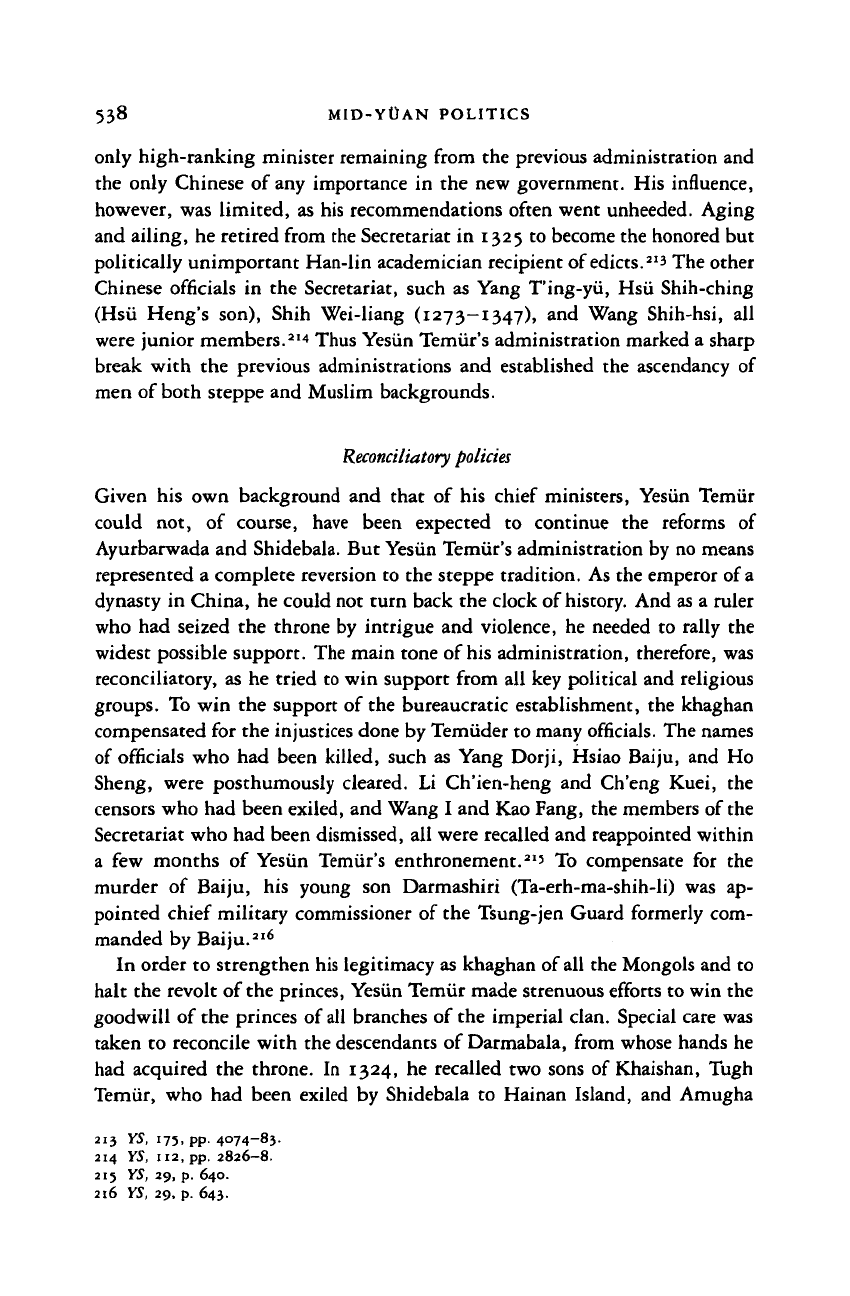
538 MID-YOAN POLITICS
only high-ranking minister remaining from the previous administration and
the only Chinese of any importance in the new government. His influence,
however, was limited, as his recommendations often went unheeded. Aging
and ailing, he retired from the Secretariat in 1325 to become the honored but
politically unimportant Han-lin academician recipient of
edicts.
213
The other
Chinese officials in the Secretariat, such as Yang T'ing-yii, Hsu Shih-ching
(Hsu Heng's son), Shih Wei-liang (1273—1347), and Wang Shih-hsi, all
were junior members.
2
'
4
Thus Yesiin Temiir's administration marked a sharp
break with the previous administrations and established the ascendancy of
men of both steppe and Muslim backgrounds.
Reconciliatory policies
Given his own background and that of his chief ministers, Yesiin Temiir
could not, of course, have been expected to continue the reforms of
Ayurbarwada and Shidebala. But Yesiin Temiir's administration by no means
represented a complete reversion to the steppe tradition. As the emperor of
a
dynasty in China, he could not turn back the clock of
history.
And as a ruler
who had seized the throne by intrigue and violence, he needed to rally the
widest possible support. The main tone of
his
administration, therefore, was
reconciliatory, as he tried to win support from all key political and religious
groups. To win the support of the bureaucratic establishment, the khaghan
compensated for the injustices done by Temuder to many officials. The names
of officials who had been killed, such as Yang Dorji, Hsiao Baiju, and Ho
Sheng, were posthumously cleared. Li Ch'ien-heng and Ch'eng Kuei, the
censors who had been exiled, and Wang I and Kao Fang, the members of the
Secretariat who had been dismissed, all were recalled and reappointed within
a few months of Yesiin Temiir's enthronement.
21
' To compensate for the
murder of Baiju, his young son Darmashiri (Ta-erh-ma-shih-li) was ap-
pointed chief military commissioner of the Tsung-jen Guard formerly com-
manded by Baiju.
216
In order to strengthen his legitimacy as khaghan of
all
the Mongols and to
halt the revolt of the princes, Yesiin Temiir made strenuous efforts to win the
goodwill of the princes of
all
branches of the imperial clan. Special care was
taken to reconcile with the descendants of Darmabala, from whose hands he
had acquired the throne. In 1324, he recalled two sons of Khaishan, Tugh
Temiir, who had been exiled by Shidebala to Hainan Island, and Amugha
213
YS,
175, pp. 4074-83.
214
YS,
112, pp. 2826-8.
215 YS, 29, p.
640.
216 YS, 29, p. 643.
Cambridge Histories Online © Cambridge University Press, 2008
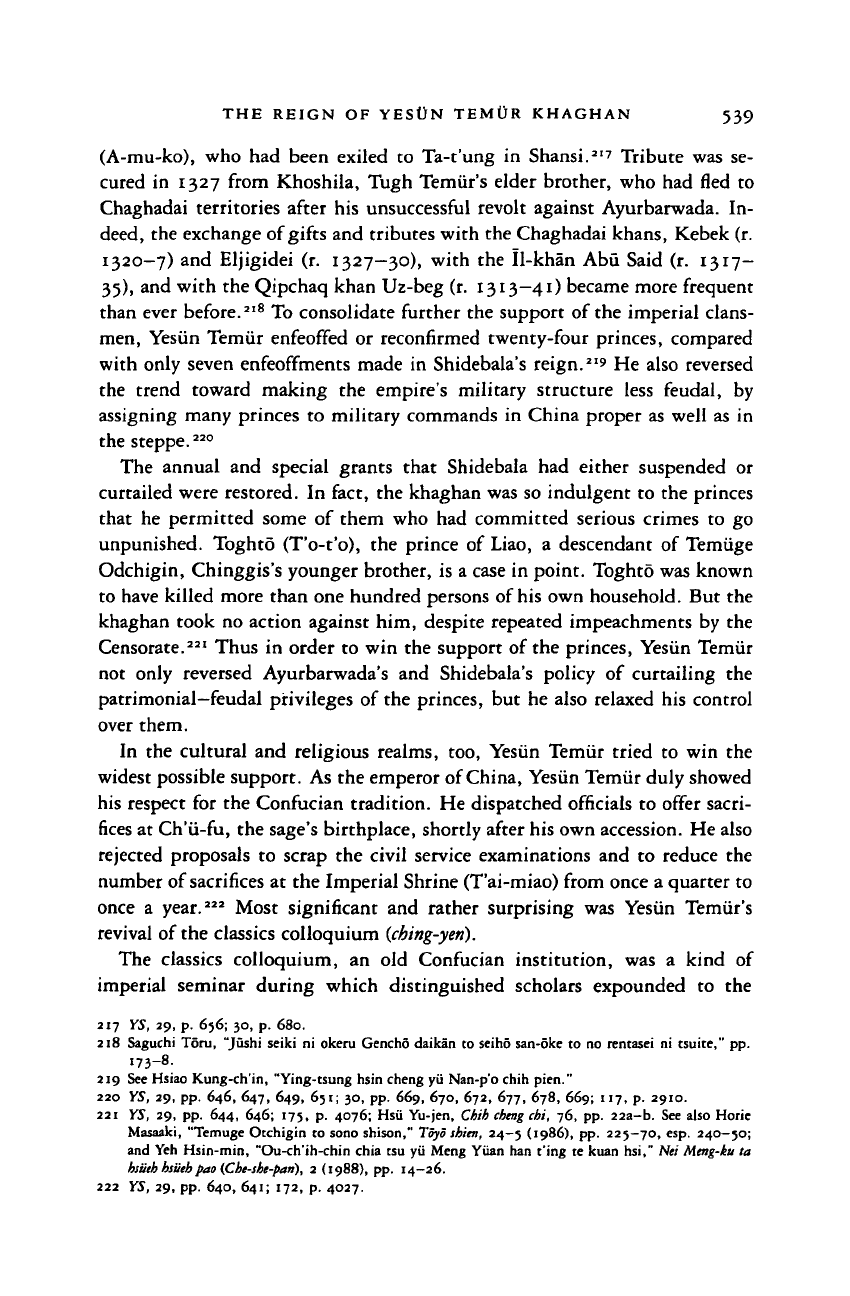
THE REIGN OF YESt)N TEMOR KHAGHAN 539
(A-mu-ko), who had been exiled to Ta-t'ung in Shansi.
2
'
7
Tribute was se-
cured in 1327 from Khoshila, Tugh Temiir's elder brother, who had fled to
Chaghadai territories after his unsuccessful revolt against Ayurbarwada. In-
deed, the exchange of gifts and tributes with the Chaghadai khans, Kebek (r.
1320-7) and Eljigidei (r. 1327-30), with the Il-khan Abu Said (r. 1317-
35),
and with the Qipchaq khan Uz-beg (r. 1313-41) became more frequent
than ever before.
2
'
8
To consolidate further the support of the imperial clans-
men, Yesiin Temiir enfeoffed or reconfirmed twenty-four princes, compared
with only seven enfeoffments made in Shidebala's reign.
2
'
9
He also reversed
the trend toward making the empire's military structure less feudal, by
assigning many princes to military commands in China proper as well as in
the steppe.
220
The annual and special grants that Shidebala had either suspended or
curtailed were restored. In fact, the khaghan was so indulgent to the princes
that he permitted some of them who had committed serious crimes to go
unpunished. Toghto (T'o-t'o), the prince of Liao, a descendant of Temiige
Odchigin, Chinggis's younger brother, is a case in point. Toghto was known
to have killed more than one hundred persons of his own household. But the
khaghan took no action against him, despite repeated impeachments by the
Censorate.
221
Thus in order to win the support of the princes, Yesiin Temiir
not only reversed Ayurbarwada's and Shidebala's policy of curtailing the
patrimonial—feudal privileges of the princes, but he also relaxed his control
over them.
In the cultural and religious realms, too, Yesiin Temiir tried to win the
widest possible support. As the emperor of China, Yesiin Temiir duly showed
his respect for the Confucian tradition. He dispatched officials to offer sacri-
fices at Ch'ii-fu, the sage's birthplace, shortly after his own accession. He also
rejected proposals to scrap the civil service examinations and to reduce the
number of sacrifices at the Imperial Shrine (T'ai-miao) from once a quarter to
once a year.
222
Most significant and rather surprising was Yesiin Temiir's
revival of the classics colloquium
(ching-yeri).
The classics colloquium, an old Confucian institution, was a kind of
imperial seminar during which distinguished scholars expounded to the
217 YS, 29, p. 656; 30, p. 680.
218
Saguchi
Tom,
"Jushi seiki
ni
okeru Gencho daikan
to
seiho san-oke
to no
rentasei
ni
tsuite,"
pp.
173-8.
219 See
Hsiao
Kung-ch'in,
"Ying-tsung hsin cheng
yii
Nan-p'o chih
pien."
220 YS, 29, pp. 646, 647, 649, 651; 30, pp. 669, 670, 672, 677, 678, 669; 117, p. 2910.
221 YS, 29, pp. 644, 646; 175, p. 4076; Hsu
Yu-jen,
Chih chmg
chi, 76, pp. 22a-b. See
also Horie
Masaaki,
"Temuge Otchigin
to
sono
shison,"
Toyo
shim, 24-5 (1986), pp. 225—70, esp. 240—50;
and Yeh
Hsin-min,
"Ou-ch'ih-chin chia
tsu yii
Meng Yuan
han
t'ing
te
kuan
hsi," Net
Meng-ku
ta
hsiith hsiieh
pao
(Che-she-pan),
2 (1988), pp. 14-26.
222 YS, 29, pp. 640, 641; 172, p.
4027.
Cambridge Histories Online © Cambridge University Press, 2008
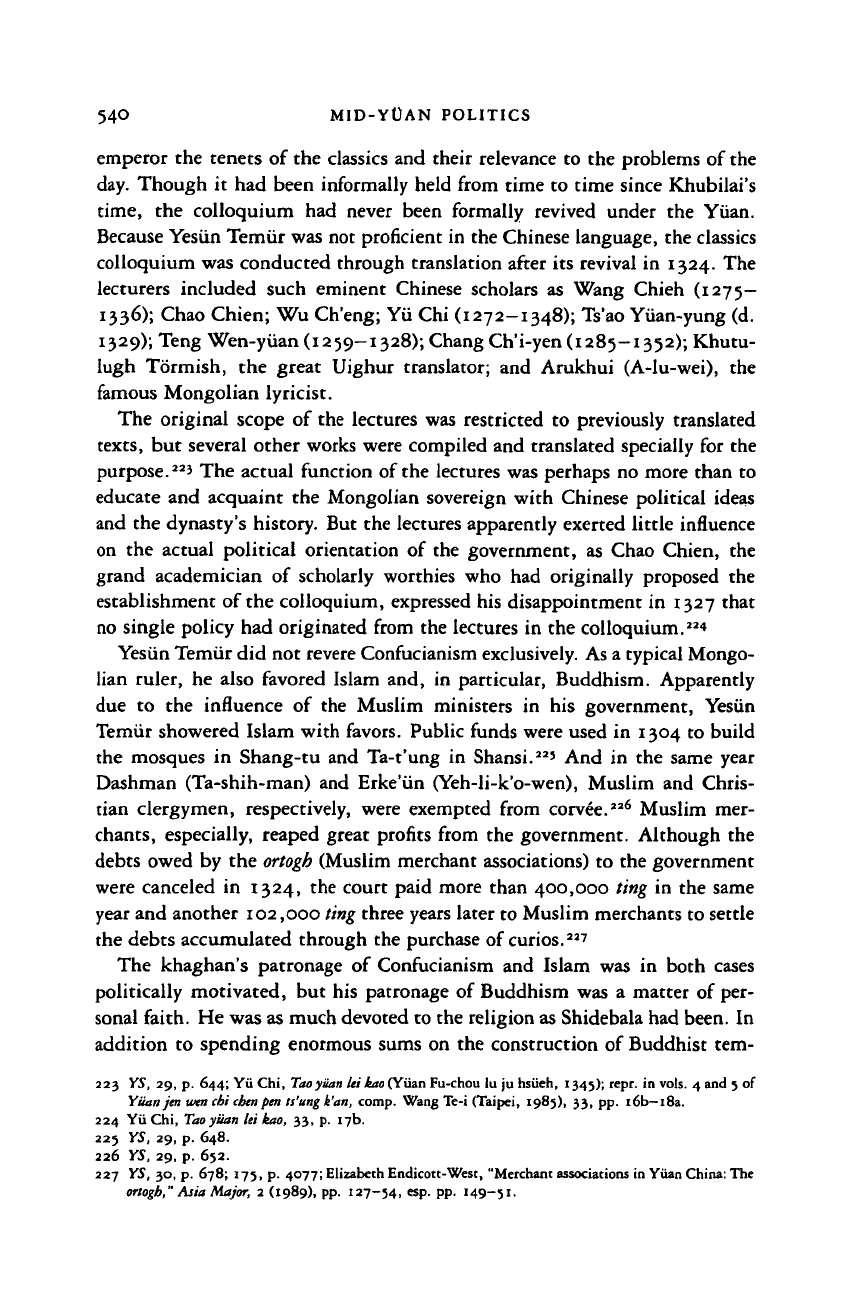
54O MID-YOAN POLITICS
emperor the tenets of the classics and their relevance to the problems of the
day. Though it had been informally held from time to time since Khubilai's
time,
the colloquium had never been formally revived under the Yuan.
Because Yesiin Temiir was not proficient in the Chinese language, the classics
colloquium was conducted through translation after its revival in 1324. The
lecturers included such eminent Chinese scholars as Wang Chieh (1275-
1336);
Chao Chien; Wu Ch'eng; Yii Chi (1272-1348); Ts'ao Yiian-yung (d.
1329);
Teng Wen-yuan (1259-1328); Chang Ch'i-yen (1285-1352); Khutu-
lugh Tormish, the great Uighur translator; and Arukhui (A-lu-wei), the
famous Mongolian lyricist.
The original scope of the lectures was restricted to previously translated
texts,
but several other works were compiled and translated specially for the
purpose.
22
' The actual function of the lectures was perhaps no more than to
educate and acquaint the Mongolian sovereign with Chinese political ideas
and the dynasty's history. But the lectures apparently exerted little influence
on the actual political orientation of the government, as Chao Chien, the
grand academician of scholarly worthies who had originally proposed the
establishment of the colloquium, expressed his disappointment in 1327 that
no single policy had originated from the lectures in the colloquium."*
Yesiin Temiir did not revere Confucianism exclusively. As a typical Mongo-
lian ruler, he also favored Islam and, in particular, Buddhism. Apparently
due to the influence of the Muslim ministers in his government, Yesiin
Temiir showered Islam with favors. Public funds were used in 1304 to build
the mosques in Shang-tu and Ta-t'ung in Shansi."' And in the same year
Dashman (Ta-shih-man) and Erke'iin (Yeh-li-k'o-wen), Muslim and Chris-
tian clergymen, respectively, were exempted from corvee.
226
Muslim mer-
chants, especially, reaped great profits from the government. Although the
debts owed by the
ortogh
(Muslim merchant associations) to the government
were canceled in 1324, the court paid more than 400,000 ting in the same
year and another 102,000
ting
three years later to Muslim merchants to settle
the debts accumulated through the purchase of curios."?
The khaghan's patronage of Confucianism and Islam was in both cases
politically motivated, but his patronage of Buddhism was a matter of per-
sonal faith. He was as much devoted to the religion as Shidebala had been. In
addition to spending enormous sums on the construction of Buddhist tem-
223 YS, 29, p. 644; Yii Chi,
Too yuan
lei kao (Yuan Fu-chou lu ju hsiieh, 1343); repc. in vols. 4 and 5 of
Yiian jen wen chi chat pen ts'ung k'an, comp. Wang Te-i (Taipei, 1985), 33, pp. 16b—18a.
224 Yii Chi,
Too
yiian lei kao, 33, p. 17b.
225 YS, 29, p. 648.
226 YS, 29, p. 652.
227 YS, 30, p. 678; 175, p. 4077; Elizabeth Endicott-West, "Merchant associations in Yiian China: The
ortogh,"
Asia Major, 1 (1989), pp. 127-54, esp. pp. 149-51.
Cambridge Histories Online © Cambridge University Press, 2008
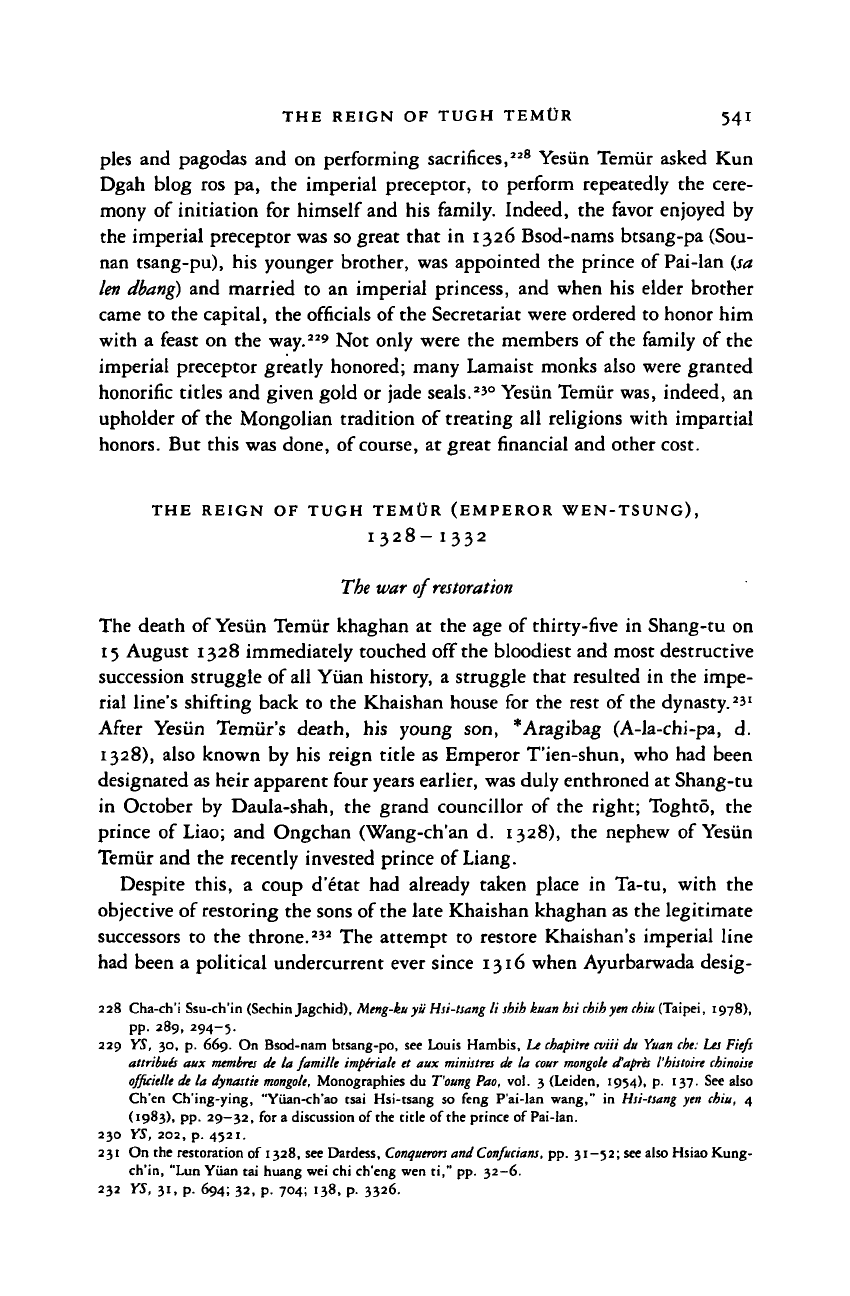
THE REIGN OF TUGH TEMUR 541
pies and pagodas and on performing sacrifices,
228
Yesiin Temiir asked Kun
Dgah blog ros pa, the imperial preceptor, to perform repeatedly the cere-
mony of initiation for himself and his family. Indeed, the favor enjoyed by
the imperial preceptor was so great that in 1326 Bsod-nams btsang-pa (Sou-
nan tsang-pu), his younger brother, was appointed the prince of Pai-lan (sa
ten dbang) and married to an imperial princess, and when his elder brother
came to the capital, the officials of the Secretariat were ordered to honor him
with a feast on the way.
229
Not only were the members of the family of the
imperial preceptor greatly honored; many Lamaist monks also were granted
honorific titles and given gold or jade seals.
2
'
0
Yesiin Temiir was, indeed, an
upholder of the Mongolian tradition of treating all religions with impartial
honors. But this was done, of course, at great financial and other cost.
THE REIGN OF TUGH TEMUR (EMPEROR WEN-TSUNG),
1328-1332
The war of restoration
The death of Yesiin Temiir khaghan at the age of thirty-five in Shang-tu on
15 August 1328 immediately touched off the bloodiest and most destructive
succession struggle of all Yuan history, a struggle that resulted in the impe-
rial line's shifting back to the Khaishan house for the rest of the
dynasty.
2
3"
After Yesiin Temiir's death, his young son, *Aragibag (A-la-chi-pa, d.
1328),
also known by his reign title as Emperor T'ien-shun, who had been
designated as heir apparent four years earlier, was duly enthroned at Shang-tu
in October by Daula-shah, the grand councillor of the right; Toghto, the
prince of Liao; and Ongchan (Wang-ch'an d. 1328), the nephew of Yesiin
Temiir and the recently invested prince of Liang.
Despite this, a coup d'etat had already taken place in Ta-tu, with the
objective of restoring the sons of the late Khaishan khaghan as the legitimate
successors to the throne.
232
The attempt to restore Khaishan's imperial line
had been a political undercurrent ever since 1316 when Ayurbarwada desig-
228 Cha-ch'i Ssu-ch'in (Sechin Jagchid), Meng-kuyti Hsi-tsang it shih kuan hsi chihyen
chiu
(Taipei, 1978),
pp.
289, 294-5.
229 YS, 30, p. 669. On Bsod-nam btsang-po, see Louis Hambis, he
chapitre
cviii du Yuan
cbe:
La Fiefs
attribute aux
membres
de la famille imptriale et aux ministres de la
cour mongolt
d'apr'a
I'histoire
cbinoise
offuielle
de la dyaastie
mongolt,
Monographies du
T'oung
Poo, vol. 3 (Leiden, 1954), p- 137. See also
Ch'en Ch'ing-ying, "Yiian-ch'ao tsai Hsi-tsang so feng P'ai-lan wang," in Hsi-tsang yen chiu, 4
(1983),
pp. 29—32, for a discussion of the title of the prince of Pai-lan.
230 YS, 202, p. 4521.
231 On the restoration of 1328, see Dardess,
Conquerors
and
Confucians,
pp. 31-52; see also Hsiao Kung-
ch'in,
"Lun Yuan tai huang wei chi ch'eng wen ti," pp. 32-6.
232 YS, 31, p. 694; 32, p. 704; 138, p. 3326.
Cambridge Histories Online © Cambridge University Press, 2008
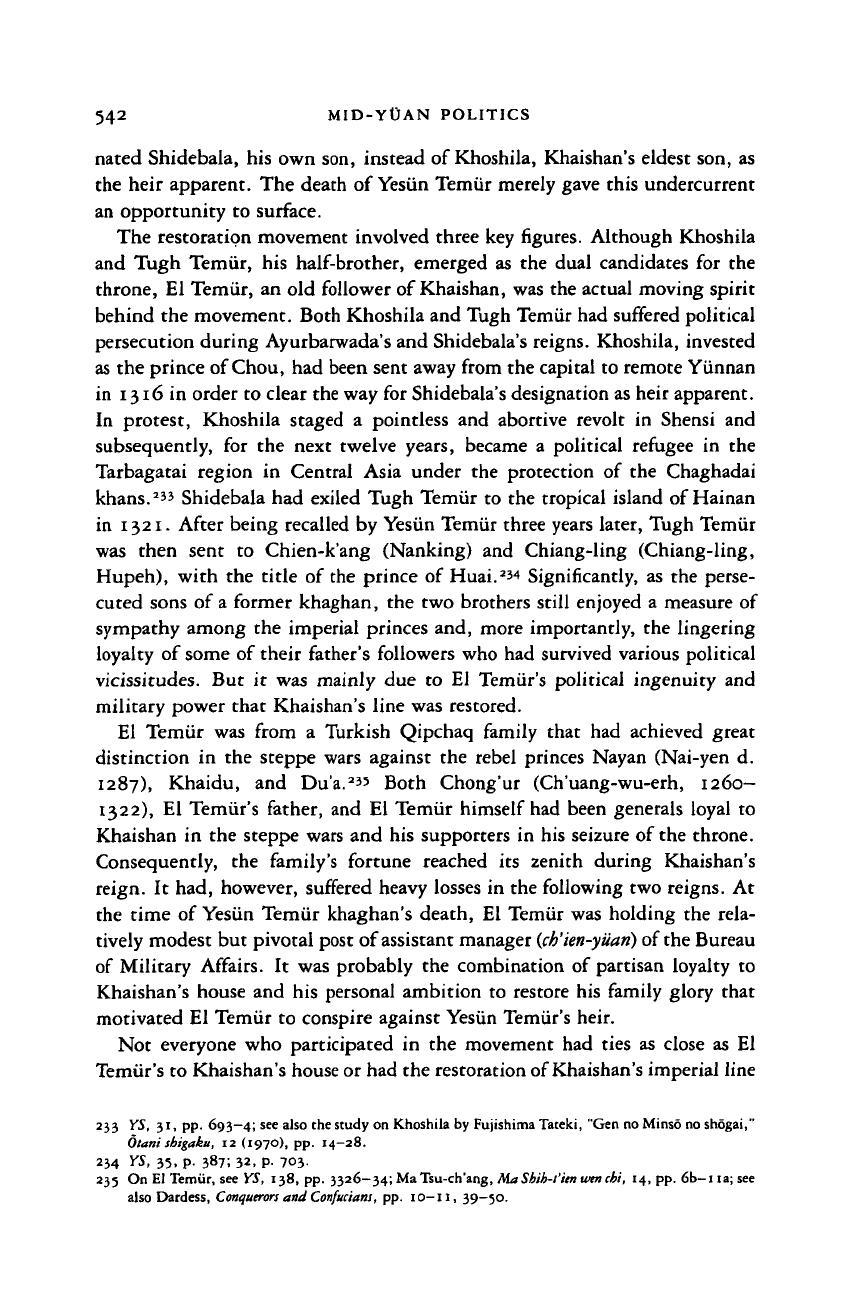
542 MID-Y(JAN POLITICS
nated Shidebala, his own son, instead of Khoshila, Khaishan's eldest son, as
the heir apparent. The death of Yesiin Temiir merely gave this undercurrent
an opportunity to surface.
The restoration movement involved three key figures. Although Khoshila
and Tugh Temiir, his half-brother, emerged as the dual candidates for the
throne, El Temiir, an old follower of Khaishan, was the actual moving spirit
behind the movement. Both Khoshila and Tugh Temiir had suffered political
persecution during Ayurbarwada's and Shidebala's reigns. Khoshila, invested
as the prince of Chou, had been sent away from the capital to remote Yunnan
in 1316 in order to clear the way for Shidebala's designation as heir apparent.
In protest, Khoshila staged a pointless and abortive revolt in Shensi and
subsequently, for the next twelve years, became a political refugee in the
Tarbagatai region in Central Asia under the protection of the Chaghadai
khans.
2
"
Shidebala had exiled Tugh Temiir to the tropical island of Hainan
in 1321. After being recalled by Yesiin Temiir three years later, Tugh Temiir
was then sent to Chien-k'ang (Nanking) and Chiang-ling (Chiang-ling,
Hupeh), with the title of the prince of Huai.
234
Significantly, as the perse-
cuted sons of a former khaghan, the two brothers still enjoyed a measure of
sympathy among the imperial princes and, more importantly, the lingering
loyalty of some of their father's followers who had survived various political
vicissitudes. But it was mainly due to El Temiir's political ingenuity and
military power that Khaishan's line was restored.
El Temiir was from a Turkish Qipchaq family that had achieved great
distinction in the steppe wars against the rebel princes Nayan (Nai-yen d.
1287),
Khaidu, and Du'a.
235
Both Chong'ur (Ch'uang-wu-erh, 1260—
1322),
El Temiir's father, and El Temiir himself had been generals loyal to
Khaishan in the steppe wars and his supporters in his seizure of the throne.
Consequently, the family's fortune reached its zenith during Khaishan's
reign. It had, however, suffered heavy losses in the following two reigns. At
the time of Yesiin Temiir khaghan's death, El Temiir was holding the rela-
tively modest but pivotal post of assistant manager
(ch'ien-yuan)
of
the
Bureau
of Military Affairs. It was probably the combination of partisan loyalty to
Khaishan's house and his personal ambition to restore his family glory that
motivated El Temiir to conspire against Yesun Temiir's heir.
Not everyone who participated in the movement had ties as close as El
Temiir's to Khaishan's house or had the restoration of Khaishan's imperial line
233 YS, 31, pp. 693—4; see also the study on Khoshila by FujishimaTateki, "Gen noMinso no shogai,"
Otani sbigaku, 12 (1970), pp. 14-28.
234 YS, 35, p. 387; 32, p. 703.
235 On El Temiir, see YS, 138, pp. 3326-34; Ma Tsu-ch'ang, Ma Shih-t'ienwm chi, 14, pp. 6b-na; see
also Dardess,
Conquerors
and
Confucians,
pp.
10-11,
39-50.
Cambridge Histories Online © Cambridge University Press, 2008
